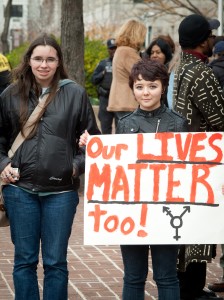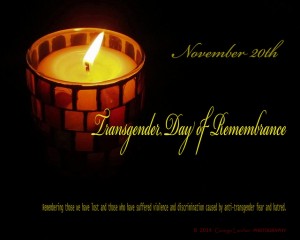How Days of Action Work in Addressing Police Bias and Anti-Transgender Violence
Today in hundreds of cities and towns across the world transgender and gender-nonconforming people and their allies pause to honor our fallen heroes. The Transgender Day of Remembrance (TDOR) was founded in 1998 by Gwendolyn Ann Smith—a transgender graphic designer, columnist, and activist—to memorialize the murder of Rita Hester in Allston, Massachusetts. It occurs annually on (or around) November 20, and its overarching goal is to bring attention to the continued violence endured by the transgender community with the hope that together we can end such violence and intolerance.
Not long ago, Washington, DC, found itself in the midst of an epidemic of violence and murders against transgender people. The rates had been steadily growing over 10 years and suddenly we suffered 4 murders in less than 3 months. (The increase in discrimination was perhaps due to a backlash against the migration of many transgender people to DC, from Virginia and elsewhere, wanting to live in a city that had, and still has, the country’s most comprehensive human rights protections for gender-nonconforming people.)
Vigil followed vigil and soon it was time for our annual TDOR. But we decided to add on a more immediate and visible Transgender Day of Action to bring this outrageous state of affairs to the forefront of public consciousness and the media and put the police, city officials, and the U.S. Attorney for Washington, DC, on notice.
In 2011, we started with just 5 people who met once or twice a week to hear directly from survivors of anti-trans violence and police harassment because any action to be effective would have to be grounded in real-world circumstances. We called ourselves the TLGB Police Watch, and eventually represented a coalition that included more than a dozen local organizations which turned these community concerns into goals, a set of demands, and a plan for a day of non-violence civil disobedience.
Within 24 hours after putting boots on the ground, at the Metropolitan Police Headquarters to City Hall and the offices of the U.S. Attorney of Washington, cold cases were reopened, the constitutionality of Prostitution Free Zones was questioned, police training efforts changed, and conference rooms once closed to transgender issues were opened wide.
At an international trans health conference the following spring, we reported out to trans activists from other cities, providing training and materials based on our success in effectively slowing the rates of violent incidents and murders.
Subsequent DC days of actions started popping up at other times during the year, fighting for healthcare access, employment opportunities, and housing nondiscrimination. The number of activists working directly on trans issues in DC right now includes more than 100 people and most of the organizations that were originally part of the TLGB Police Watch coalition.
The important take away is that days of action work and will continue work in visibly fighting this scourge of our community. It is an educational and effective way to make your demands heard and bring about change. The only requirement is your determination to organize across a spectrum of stakeholders, and then show up to do the work. Anyone who wants help in organizing a Transgender Day of Action in their community anytime of the year can tap into our resources and/or contact us for assistance and support.
DC was home city up until about 18 months ago, and tonight my heart and soul (and continuing support) are with all my friends there. Love is what it is all about because it has the power to extinguish hate in our world. Let’s work together to make world a place that is safe for everyone and human rights reign.
#####


